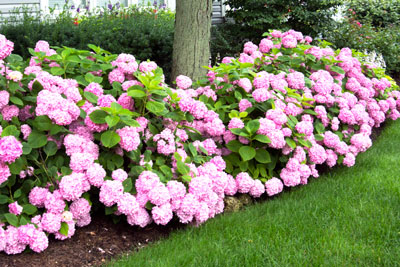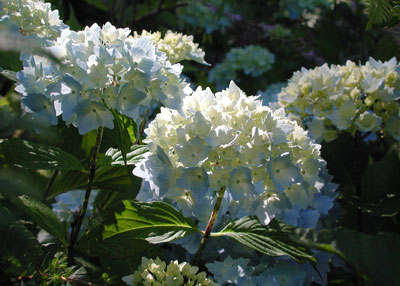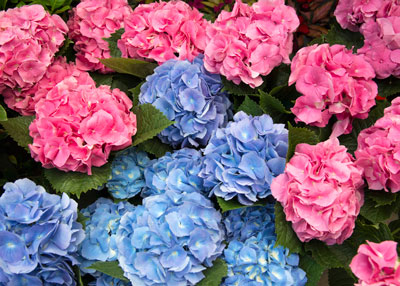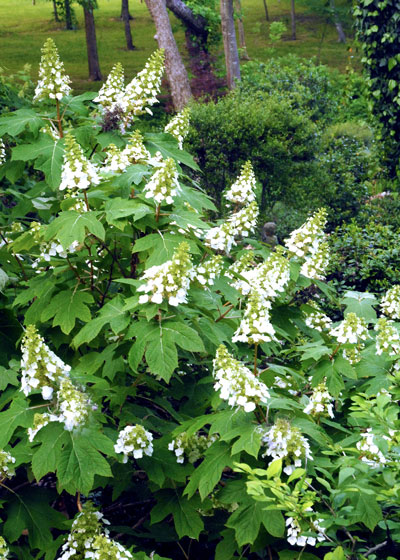Hydrangeas: Blessings or Curse?

Hydrangeas require shade, moisture.
For people who live in humid areas of Texas where soils are acidic, hydrangeas are stunning sources of color each spring. But starting at the Sabine River, with every step you take heading west, the poorer your chances of succeeding with “mophead” (florist) hydrangeas become.
I live in the DFW area, and for me with my highly alkaline black clay gumbo soil, hydrangeas are a workout. Enough so, that I’d probably not plant more than one or two in my garden, and only at very specific spots.

Every year new varieties of hydrangeas are introduced. Try one before you plant many.
The problems folks have in growing hydrangeas are partly related to low humidities in the summer. They have giant leaves that require constantly moist soil to keep them healthy and vigorous. If the plants wilt repeatedly, they’re probably going to falter. Now, all hydrangeas will wilt when the full sun hits their leaves. The difference is that I’m talking about wilting when they’re not in the sun.
So sunlight isn’t their ally, since it causes transpiration to accelerate. The large leaves just can’t pull the water up into the plants quickly enough. Plant them where they’ll get perhaps 2 or 3 hours of direct sunlight in the early morning, then shade the rest of the day. They’re good companions for ferns, hostas and English ivy, for example.
And third challenge: the alkaline soils most of us in the western 80 percent of Texas encounter aren’t friendly to hydrangeas at all. Iron is a critical mineral element for them, and iron becomes insoluble in alkaline soils. The plants show characteristic symptoms of iron deficiency: yellowed (almost white) leaves, most pronounced at the ends of the branches. You can apply an iron/sulfur soil additive to help green them up, but keep it off masonry and painted surfaces that could be stained. And, if you’re in such an area with alkaline soils, plant new hydrangeas into garden soil that has been highly amended with sphagnum peat moss and finely ground pine bark mulch, much as you would for azaleas.
Gardeners in East Texas don’t understand all this fuss. For you, hydrangeas are big, beautiful spring flowers that shine beneath the pine forests. All you have to do is fertilize them sparingly with nitrogen after spring bloom, and give them enough moisture to keep them growing and vigorous.
If you have hydrangeas that need to be pruned, do so immediately after their floral bracts have turned brown. That will reshape the plants and still give them ample time to regrow and bloom next spring. (That is also the perfect time to fertilize them.) Unless your plant is hurt by extreme cold, you must not prune it in winter.

What’s this “litmus paper” thing about hydrangeas?
Mophead hydrangeas produce blue floral bracts in acidic soils of East Texas. The same variety will probably produce pink floral bracts in alkaline soils, for example, along I-35 and westward. Of course, it’s much more difficult to get good hydrangea blooms at all in West Texas due to soil and climate.
Some research I’ve seen says that it’s the aluminum in the soil that determines the “blueness.” Most of us learned early on that we should apply aluminum sulfate to turn pink hydrangeas blue, and to turn blue hydrangeas pink, we would add dolomitic limestone to raise the soil’s pH. Adding phosphorus will also hinder the uptake of aluminum by the roots. But that’s a slippery slope. If you fall short in these color changes, you can end up with a big pot full of floral bracts that aren’t pink or blue, but some brown shade in between.
It’s all still pretty confusing for most home gardeners. My feeling is that it’s usually best to enjoy whatever color your hydrangeas chooses for itself, but if you’re just determined to make a big color change, here is a page that give you lots more detail on the topic.
Other Hydrangeas…
I’ve found it much more rewarding to grow oakleaf hydrangeas (Hydrangea quercifolia). They’re woody shrubs that grow to 5 or 6 feet tall and 6 to 8 feet wide. Their leaves are start-shaped and the sizes of dinner plates. It’s a deciduous variety, so its leaves drop in late fall. As they do, they turn lovely shades of rich reds.
This is one of the most functional shade shrubs I have in my landscape. But once again, I have to apply iron and sulfur, and they must be in the shade in moist, highly organic soil. As shaded as our landscape is, I can’t imagine trying to colorize it this time of year without my oakleaf hydrangeas. That’s why we have 15 or 20 of them.

This is my view out my home office windows when our oakleaf hydrangeas are in full flower.
